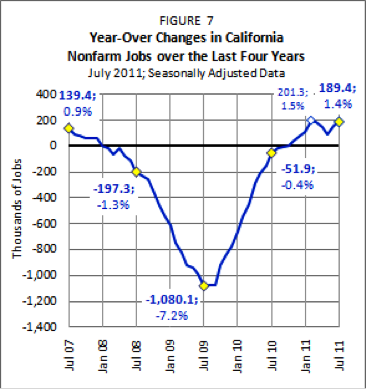In California, we head into Labor Day 2011 with an
unemployment rate of 12%, and 2,257,000 Californians counted as unemployed. This
is an improvement over Labor Day 2010, when unemployment was at 12.4% and 2,330,000
Californians were unemployed . But, as previously detailed in Fox and Hounds,
this economic recovery has been very slow, far slower than previous recoveries
in California, and predictions are for unemployment to continue over 10% for
some time. We have reached the Jobs
Perplex.
The past year has seen a small group of California industries
expanding employment. Nearby my office,
in the South of Market area of San Francisco, hundreds of internet commerce and
social media start-ups are in active start-up mode, joining the established
Twitter, Zynga, and Salesforce.com employment generators in the area.
But technology is among the very small group of sub-sectors that
are growing significantly in employment, in San Francisco and statewide. For the most part, since Labor Day 2010 California
firms have sought to hold on to employees, not expand, as shown in the figure below
from EDD’s most recent employment briefing.

Nationwide, policy entrepreneurs have weighed in over the
past few weeks with a variety of initiatives to address the jobs perplex. These
have ranged from the traditional large-scale public works and infrastructure
investments to more exotic proposals, including one by Jonathan Alter to
use unemployment insurance payments as vouchers
to employers for new hires and a second
by Mickey Kaus (channeling economist Martin Weizman) for flexible pay
for workers.
In California, the job creation approaches have been more
grounded in fiscal and political realities. Last week, Governor Brown proposed
a series of tax measures to stimulate hiring, including a sales tax exemption
for purchases of manufacturing equipment (paid for by eliminating a tax benefit
that allows companies to pick the less expensive of two tax formulas). He also
proposed expanding an employer tax
credit and increasing the amount per employee from $3000 to $4000.
These approaches are aimed at private sector growth, arise
from California industry, and will not have significant impact on the budget. It’s difficult to understand the opposition,
other than ideology; and the weeks
following Labor Day 2011 will be an appropriate time to move these forward.
For the long run, though, Labor Day 2011 might be a start
for California government also to address another part of our state’s jobs perplex: the enormous gap that has arisen
over the past 40 years between government entitlements and work, to better
connect our CalWORKS welfare system, Unemployment insurance System, and Social Security Insurance/Social Security
Disability Insurance (SSI/SSDI) system to jobs.
The 1996 federal welfare reform act sought to rebuild the
nexus between welfare payments and work. Though implementation has been
mixed in results , the principle was the right one: reorient the system toward
job placement. Even as job placements become most difficult to achieve, the
commitment to this jobs orientation cannot be lost.
California’s Unemployment Insurance system has been in the
press the past few years mainly because it, like the systems of most states,
has been operating in the red. Yet, beyond
the solvency issue is work orientation. The UI system is a 1930s system that is
aimed at paying benefits. It has a re-employment mission and structure, but a
limited one.
The SSI/SSDI system is the entitlement system most out of
control and removed from work. Nationwide it has grown from 6.6 million recipients
in 2000 to 10.2 million recipients in
2010; with more than one million recipients in California. While part of this
increase has been a movement of persons from welfare to SSI/SSDI; a greater
part has been the rush to get persons with disabilities on the SSI/SSDI rolls,
and the little the system has to offer in job placement. The community job
training groups that work with persons with disabilities, such as the ARCs of
California, scratch and struggle for each placement.
What sense does it make to speak of new job placement structures for SSI/SSDI
recipients or welfare recipients or UI recipients in this time of job scarcity?
Each job opening in California continues to get tens of applicants or more; the
Bureau of Labor Statistics reports roughly five unemployed workers for each job
opening.
I don’t have the
answer. Unlike other policy entrepreneurs, I don’t have a 10-point jobs plan,
or a 6-point jobs plan, or even a 1-point jobs plan. But I do know that
work-rather-than-entitlements is precisely the discussion that should begin in
California on Labor Day 2011. The idea of a California economy in which a good
portion of the workforce is on
government entitlements would have unthinkable 20 or 30 years ago.
Is that the ghost of Gus Hawkins I see in our Capitol
hallways?

